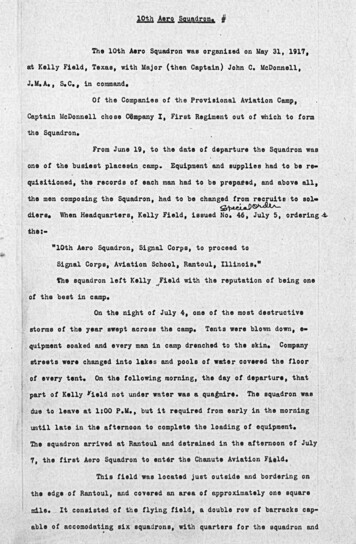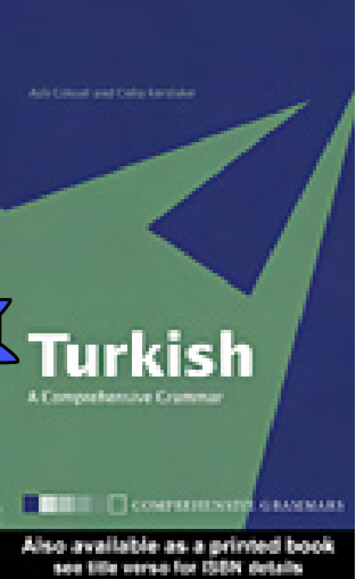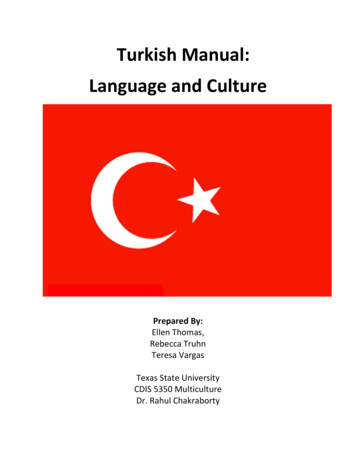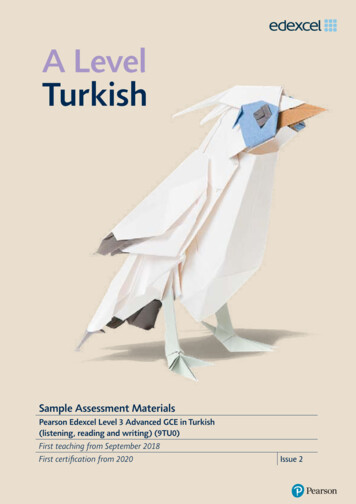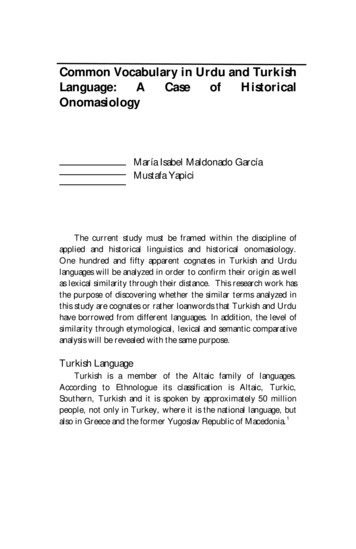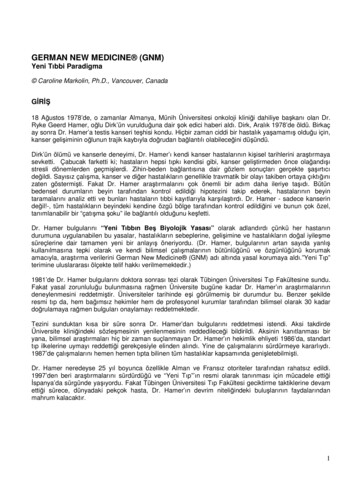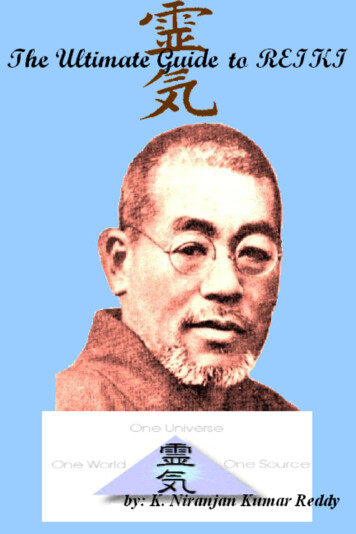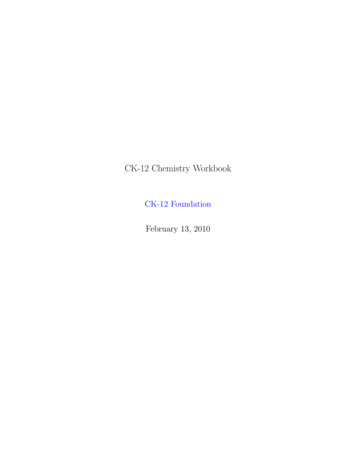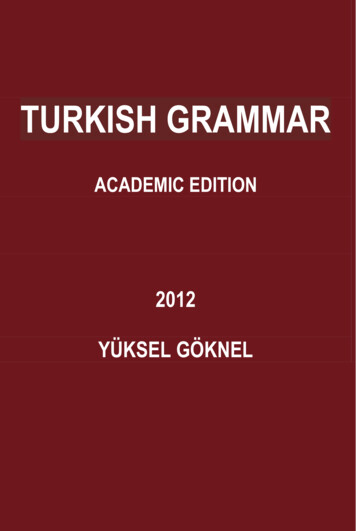
Transcription
TURKISH GRAMMARACADEMIC EDITION2012YÜKSEL GÖKNEL
TURKISH GRAMMAR ACADEMIC EDITION 20121
TURKISH GRAMMAR ACADEMIC EDITION 2012TURKISH GRAMMARACADEMIC EDITION2012YÜKSEL GÖKNEL2
TURKISHACADEMICGRAMMAREDITION 2012TURKISH GRAMMARFOREWORDThe Turkish Grammar book that you have just started reading is quite differentfrom the grammar books that you read in schools. This kind of Grammar is known astraditional grammar. The main difference of a traditional grammar and that of atransformational one is that the first one describes a natural language as a staticobject, but the second one describes both the parts of the language engine and howit runs. This is like learning about a motionless car. There is something lacking in thisdescription. It is the dynamics of the parts of a car that runs a hundred and twentykilometers an hour.Traditional grammars describe only the physical appearance of a language; theydo not mind what goes on behind the curtain. The mind of a human being works likethe engine of a sports car. It arranges and chooses words matching one another,transforms simple sentence units to use in different parts of sentences, and recollectsmorphemes and phonemes to be produced by the human speech organs. All theseactivities are simultaneously carried out by the human mind.Another point that the traditional grammarians generally miss is that they write thegrammar of a certain language to teach it to those who have been learning it from thetime when they were born up to the time when they discover something calledgrammar. This is like teaching a language to professional speakers.Then, what is the use of a grammar? I believe most people were acquainted withit when they started learning a foreign language. Therefore, a grammar written forthose who are trying to learn a second language is very useful both in teaching andlearning a second language.I started teaching English as a second language in 1952, a long time ago. Yearspassed and one day I found myself as a postgraduate Fulbright student at theUniversity of Texas at Austin in 1960. Although I studied there for only a short period,I learnt enough from Prof. Archibald A. Hill and Dr. De Camp to stimulate me to learnmore about Linguistics.After I came back to Turkey, it was difficult to find books on linguistics inbooksellers in Istanbul. Thanks to The American Library in Istanbul, I was able toborrow the books that attracted my attention.In those books, I discovered Noam Chomsky, whose name I had not heard during mystay in the U.S.A.I must confess that I am indebted to the scholars and the library above in writingthis Turkish Grammar.I am also grateful to my son Dr. Özgür Göknel who encouraged me to write thisbook and to Vivatinell Warwick U.K., which sponsored to publish it.YÜKSEL GÖKNEL3
TURKISH GRAMMAR ACADEMIC EDITION 20124
TURKISH GRAMMAR ACADEMIC EDITION 20125
TURKISH GRAMMAR ACADEMIC EDITION 2012TURKISH GRAMMARACADEMIC EDITIONYÜKSEL GÖKNELVivatinell Bilim-Kültür Yayınları2012Grafik Tasarım UygulamalarıVivatinell PressSelami Burhan GÖKAYVivatinell CosmopharmaceuticsFetih Mah. Tunca Sk. No:2 34704Ataşehir / İstanbul / TÜRKİYETel: 90 216 470 09 44Faks: 90 216 470 09 486
TURKISH GRAMMAR ACADEMIC EDITION 2012CONTENTSForewordContentsLogical, Morphemic, and Oral SequencingThe Turkish GrammarThe Turkish Vowel and Consonant Harmony37131617The Vowel Harmony SequenceThe Consonant HarmonyMorphemes and AllomorphsDerivational Morphemes and Their AllomorphsMorphemes Attached to Nouns to Produce NounsMorphemes Attached to Nouns to Produce AdjectivesMorphemes Attached to Adjectives to Produce NounsMorphemes Attached to Verbs to Produce NounsMorphemes Attached to Verbs to Produce AdjectivesMorphemes Attached to Nouns to Produce VerbsMorphemes Attached to Adjectives to Produce VerbsInflectional Morphemes and Their AllomorphsNominal PhrasesAdverbs and AdverbialsThe Transformational Activity of the LogicForm and Function in LanguagesUsing Adjectives as AdverbsThe Inflectional MorphemesThe Defining [İ] Morpheme and Its Allomorphs [i, ı, ü, u]The [LE], [LE.YIN] and [E], [DE], [DEN] Inflectional Morphemes[LE] allomorphs: [le, la][LE.YIN]:[E], [DE], [DEN] and [LE] Morphemes[E] allomorphs: [e, a][DE] allomorphs: [de, da, te, ta][DEN] allomorphs: [den, dan, ten, tan]“Possessor Possessed” Noun Compounds (İsim Tamlamaları)Definite Noun Compounds (Belirtili İsim Tamlamaları)Indefinite Noun Compounds (Belirtisiz İsim Tamlamaları)Noun Compounds Without Suffixes (Takısız Tamlamalar)Noun Infinitive Compounds (İsim Mastar Tamlamaları)Prepositions and Postpositions (Edatlar or 35354545662646666737375767
TURKISH GRAMMAR ACADEMIC EDITION 2012Primary Stress, Secondary Stress, and Intonation[E], [DE], [DEN] Morphemes PostpositionsThe Inflectional Morphemes Attached to VerbsThe Simple Present “be”The Present Modals with Verb “be”must becan’t bemay bemay not beThe "yes - no" Questions Used With Verb "be"have to be, should be, ought to be, needn’t behave to be (zorundayım)needn’t be (gerek yok)The Simple Past Verb “be”Interrogative Words[MİŞ] (Rumor, Inference) (söylenti, anlam çıkarma)The Future Form of “be” (will be)“there is”, “there are”; “have, (have got)”there used to be, there used to havethere must (may) be, there can’t be, there is going to beImperatıves and WıshesWıshThe Simple Present Tense (Geniş Zaman)The Verbs Ending with Vowels or ConsonantsSome Nouns Used Together With “et”, yap”, “işle” to Produce VerbsThe Negative Form of The Simple Present TenseThe Simple Present Positive QuestionThe Simple Present Negative QuestionThe Question Words Used in the Simple Present TenseThe Present Continuous and the Present Perfect ContinuousThe Verbs That Are Not Used in the Simple Present in TurkishTurkish Verb Frames (Türkçede Fiil Çatıları)Transitive and Intransitive Verb FramesReflexive Verb FramesThe Passive Transformation of the Intransitive VerbsReciprocal Verb Frames (İşteş Fiiller)Both Transitively and Intransitively Used English VerbsThe Simple Past and the Present PerfectMiş’li Past Tense (Rumor and Inference) (Miş’li 48148149150152153159167
TURKISH GRAMMAR ACADEMIC EDITION 2012The Simple Future and “be going to”The Past Continuous TenseThe Past Perfect Continuous TenseWas (were) going toused toThe Rumor Forms of The Simple Present and The Present Cont.The Past Perfect TenseThe Future Continuous TenseThe Future Perfect TenseInfinitives (Mastarar)The [mek, mak] InfinitivesThe [me, ma] InfinitivesThe [iş, ış, üş, uş] InfinitivesThe [dik, dık, dük, duk, tik, tık, tük, tuk] InfinitivesWhere and How the Infinitives Are Used1.(a) The [mek, mak] Infinitives Used as Subject1.(b) The [mak, mak] Infinitives Used before Postpositions1.(c) The [mek, mak] Infinitives Used as Objects of “iste”1.(d) The [mek, mak] Infinitives Used Attached to [DEN] Morph.2.(a) The [me, ma] Infinitives Used Attached to Noun Compounds2.(b) “noun infinitive”-[İ], and “V-[me-/y/i], V-[ma]-/y/ı]2.(c) “noun infinitive”-[e, a]2.(d) “noun infinitive” Compounds Followed by [den, dan]3.(a) “noun infinitive”-[İ], [E], [DE], [DEN]4.(a) possessor noun V-[dik, dık, dük, duk, tik, tık, tük, tuk]The Passive InfinitiveModalsPresent Modalscan, may [ebil, abil]must [meli, malı]have to (zorunda)needn’t (don’t have to)should (ought to)Past ModalsCouldwas (were) able towould, could (polite request)Perfect Modalsmust 8209211211212213214214
TURKISH GRAMMAR ACADEMIC EDITION 2012can’t (couldn’t) haveshould have (ought to have)may havemight haveneedn’t havedidn’t need toTransformations (English)The Nominalization of the Simple English SentencesThe Transformation of the Simple Sentences into DeterminersThe Productivity of the Natural LanguagesTheTransformed Simple Sentences Used as Adverbial ClausesTurkish Sentence NominalizationsTurkish Simple Sentence NominalizationTransformed Nominal PhrasesThe infinitives with [me, ma]:The infinitives with [dik, dık, dük, duk, tik, tık, tük, tuk]:Simple Sentence Nominalization 1: V - [DİK] - [pers] - ([İ])The Simple Future Tense: “V-[ecek, acak]-[pers]-[İ]”The Past Perfect: “V-[miş, mış, müş, muş] ol-[duk]-[pers]-[İ]”The Future Perfect “V-[miş, mış, müş, muş] ol-[duk]]-[pers]-[İ]Simple Sentences with the Verb root “ol” (be)Chain Noun Compounds2. V- [DİK]- [pers]-([İ])V-[MİŞ] ol-[duk]-[pers]-([İ])Nominalized Sentences Containing “question words”Turkish “Determiner Determined” CompoundsSimple Sentences and Transformed Nominal PhrasesThe Passive Transformation and the Passive Verb FramesThe Verb FramesThe Structural Composition of the Causative Verb FramesA Short List of Verb FramesThe Order of MorphemesCausative Verb Frame ExamplesThe Passive CausativeSyllabicationDividing the Verb Compositions into SyllablesThe Rumor Forms of the Simple Present, Continuous and Future TensesNegative Verb CompositionsSome Example Sentences of the Verb 2268269270270279291294295
TURKISH GRAMMAR ACADEMIC EDITION 2012Adverbial Clauses (Postpositional Adverbial Phrases)Timebeforeafterwhen and whilewhileas soon asuntil“by” and “by the time”sinceCause or ReasonContrast (Rağmen)PurposePlaceMannerasas if (as though)Resultso thatsuch thato kadar adjective noun-time ki“too adjective to V için” and “adjective enough to Verb”DegreeComparative DegreeSuperlative DegreePositive or Negative EqualityParallel Proportion (Koşut Uyum)Wishwish wouldwish past subjunctivewish past perfect or perfect modalConditional SentencesPresent Real SuppositionPresent Unreal (contrary to fact) SuppositionPast Real SuppositionPast Unreal (contrary to fact) SuppositionOrders and RequestsPlain Orders and RequestsPolite RequestsPolite 383383386387388390390391392
TURKISH GRAMMAR ACADEMIC EDITION 2012Offers{ V [İP] }Question Tags ( değil mi?)So do I (Neither do I)Conjunctions and Transitional PhrasesIntensifiersReported SpeechRoots, Stems and Verb FramesRational SequencingMorphemic SequencingThe Inflectional Allomorphs Attached to Nouns and Nominal PhrasesThe Inflectional Allomorphs Attached to Action VebsDual Inflectional Allomorphs Attached to Verb Roots, Stems and FramesThe Inflectional Allomorphs Attached to "be" (ol) VerbsModal Auxiliary VerbsOral Harmonic SequencingMorphemic and Oral SequencesSymbols and 10418418420421422423425428431432
TURKISH GRAMMAR ACADEMIC EDITION 2012LOGICAL, MORPHEMIC, AND ORAL SEQUENCINGNoam Chomsky and Steven Pinker in their books assert that the humanmind has an inborn logical ability which seperates a body of thought (asentence) into two parts to produce sentences. A person thinks logically thata sentence should be about something or someone, and uses them assubjects, and uses all the information given about the subjects as predicates.Chomsky calls them Nominal Phrase and Verbal Phrase, in short "NP VP". Additionally, the predicate part (VP) is also seperated into two parts asa verb, and an object 'V NP'. These logical storages (parts) are emptybefore one starts learning his/her language. When someone starts hearingthe sounds of his language, he loads these sounds with meaning and insertsthem into these empty logical storages. The sequencing of the storages isalso learned while someone is being exposed to his native language.Therefore the sequencing of the logical storages change from language tolanguage. The logical storages and their learned sequencing are called thelogical sequence of a sentence. The so called storages are also flexibleenough to hold the shortest and the longest language units.The word verb "V" covers a verb root, a verb stem, or a verb frame, andall the inflectional suffixes attached to them such as "ed", "ing", "s", andauxiliary verbs such as "must", "may", "might", "can", "could", etc. precededby them. The verbs together with these inflectional suffixes and auxiliaryverbs constitude a verb composition concept and called a verb "V".All subjects and objects, whether long or short, are Nominal Phrases. If averb is intransitive, it does not need an object (NP), so the predicate parthas only a verb, and some adverbs or adverbials. The predicates that have"be" verbs are also considered Verbal Phrases.The sentences described above are of three kinds:1. A subject, a transitive verb, and an object: Jack killed a mouse.subjNP2. A subject and an intransitive verb: Jack sleeps.subjNPVVP3. A subject and a "be" complement: Jack is brave.subjNP13VVPVobj (NP)VP
TURKISH GRAMMAR ACADEMIC EDITION 2012Although these logical storages are inborn, their sequencing is learnedthrough the experiences of an individual. Therefore, the sequencing of thesubject and predicate, and that of the subject, verb, and object changefrom language to language. For instance in English:Iam coming.Subj (NP)pred (VP)(There are no personal suffixes attached to verbs in English.)In Turkish: Geliyor –Vum (ge*li*yo*rum)subj (NP)In Turkish, a personal concept is expressed by a personal suffix either attached to a verb at the end of a sentence, or expressed by both a pronoun inthe beginning and a suffix at the end of a sentence. Using personal suffixesattached to the ends of the Turkish sentences (except the third person singular) is a grammatical necessity.Furthermore, the subject, verb, and object sequence of the English language differs in Turkish as subject (pronoun), object, verb, subject (suffix);or object, verb, subject (suffix):English:Weare pickingsubj (pron)VçiçekTurkish 1: Bizsubj (pron)objflowers.objtopuyor-uz. We are picking flowers.V-subj (suffix)Turkish 2: Çiçek topl
learning a second language. I started teaching Engli sh as a second language in 1952, a long time ago. Years . Turkish “Determiner Determined” Compounds 250 Simple Sentences and Transformed Nominal Phrases 255 The Passive Transformation and the Passive Verb Frames 257 The Verb Frames 260 The Structural Composition of the Causative Verb Frames 261 A Short List of Verb Frames 262
